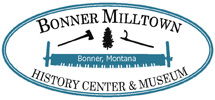 The Akerson family settled early in the Piltzville area.
The Akerson family settled early in the Piltzville area.
Several early residents are important to the Bonner-Milltown story.
Hiram Farr homesteaded in 1882, and he owned 160 acres near the first NP railroad bridge across the Big Blackfoot. In May of 1884, he sold his land (along with a cow!) to the Montana Improvement Company for $100. The deed also included his water rights, two stoves, chains, a broad ax, and "other tools and implements on said land too tedious to mention." The MIC were looking for land on which to construct a sawmill, which is known today as the Bonner Mill.
In 1881 John McCormick bought land for a farm from John F. Higgin in the area that eventually became Milltown. After the completion of the Hammond-Bonner mill in 1886, just 1/2 mile away, McCormick began to lease some of his land to the workers in the 1890s. By 1892, there were a dozen houses, a livery stable, a rooming house, and three saloons. Some of the Finns who had come to work in the mill moved to the newly leased lots after they were flooded out of their cabins along the Big Blackfoot River in 1891.
McCormick sold his farm and the existing leases to the Clark-Montana Realty Company (William Andrews Clark’s operation) in 1904. Clark immediately divided the land into lots ranging in size from 35 to 130 feet. He leased the lots to mill workers for $1.25 per month, but they had to build their own homes. Some houses from 1905 still stand today.
John Richlie was the first resident in what is now West Riverside. Initially he lived in an abandoned trappers cabin before bringing his wife Adelia and mother-in-law Barbara Zaugg from Missouri. Originally from Switzerland, the Zauggs arrived in 1884 on the newly completed Northern Pacific Railroad. The Richlies moved to the DeSmet area, but Mrs. Zaugg and her six other children “proved up” and remained in the area.
In 1887 Daniel Bandmann bought 160 acres across the Clark Fork River from Jacob Rehder, who had raised Macintosh apples there. Bandmann, who was retired, raised exotic breeds of cattle and rehearsed Shakespearian plays in the property's stable, which he remodeled into a stage. He died in 1905, but his widow Mary sold 42 acres to Clark-Montana Realty in 1910; this land became part of Clark’s Riverside Park. According to the Missoulian, this fulfilled Bandmann’s wishes. He more than once expressed his desire to be able to convert this tract of land into a park for the people of Missoula. Bandmann’s legacy lives on as the remnants of his ranch are being developed as a golf course community in the area known locally as Bandmann Flats.
